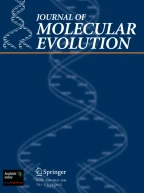Summary
The neutral theory of molecular evolution postulates that nucleotide substitutions inherently take place in DNA as a result of point mutations followed by random genetic drift. In the absence of selective constraints, the substitution rate reaches the maximum value set by the mutation rate. The rate in globin pseudogenes is about 5 × 10−9 substitutions per site per year in mammals. Rates slower than this indicate the presence of constraints imposed by negative (natural) selection, which rejects and discards deleterious mutations.
References
Kimura M (1983) The neutral theory of molecular evolution Cambridge University Press, Cambridge, England
Kimura M (1968) Evolutionary rate at the molecular level. Nature 217:624–626
Jukes TH (1980) Silent nucleotide substitutions and the molecular evolutionary clock. Science 210:973–978
Smith MM, Andrésson ÓS (1983) DNA sequences of yeast H3 and H4 histone genes from two non-allelic gene sets encode identical H3 and H4 proteins. J Mol Biol 169:663–690
Kimura M (1983) The neural theory of molecular evolution. In: Nei M, Koehn RJ (eds) Evolution of genes and proteins. Sinauer Associates, Sunderland, Massachusetts, pp 208–233
King JL, Jukes TH (1969) Non-Darwinian evolution. Science 164:788–798
Blaisdell BE (1983) Choice of base at silent codon site 3 is not selectively neutral in eucaryotic structural genes: It maintains excess short runs of weak and strong hydrogen bonding bases. J Mol Evol 19:226–236
Kimura M (1981) Possibility of extensive neutral evolution under stabilizing selection with special reference to nonrandom usage of synonymous codons. Proc Natl Acad Sci USA 78:5773–5777
Ames BN, Hartman PE (1963) The histidine operon. Cold Spring Harbor Symp Quant Biol 28:349–356
Zuckerkandl E, Pauling L (1965) Molecules as documents of evolutionary history. J Theoret Biol 8:357–366
Itano H (1957) The human hemoglobins: their properties and genetic control. Adv Protein Chem 12:216–269
Ikemura T (1981) Correlation between the abundance ofEscherichia coli transfer RNAs and the occurrence of the respective codons in its protein genes: a proposal for a synonymous codon choice that is optimal for theE. coli translational system. J Mol Biol 151:389–409
Ikemura T (1981) Correlation between the abundance ofEscherichia coli transfer RNAs and the occurrence of the respective codons in its protein genes. J Mol Biol 146:1–21
Ikemura T (1982) Correlation between the abundance of yeast transfer RNAs and the occurrence of the respective RNAs. J Mol Biol 158:573–597
Miyata T (1982) Evolutionary changes and functional constraints in DNA sequences. In: Kimura M (ed) Molecular evolution, protein polymorphism and the neutral theory. Japan Scientific Societies Press and Springer-Verlag, Berlin Heidelberg New York, pp 233–266
Milkman R (1982) Toward a unified selection theory. In: Milkman RD (ed) Perspectives on evolution. Sinauer Associates, Sunderland, Massachusetts
Milkman R (1983) Experimental population genetics. Hutchinson Ross, Stroudsburg, Pennsylvania, pp 328–334 (Benchmark papers in genetics, vol 13)
Author information
Authors and Affiliations
Additional information
We wish to dedicate this paper to the memory of Professor Jack Lester King
Rights and permissions
About this article
Cite this article
Jukes, T.H., Kimura, M. Evolutionary constraints and the neutral theory. J Mol Evol 21, 90–92 (1984). https://doi.org/10.1007/BF02100633
Received:
Revised:
Issue Date:
DOI: https://doi.org/10.1007/BF02100633
